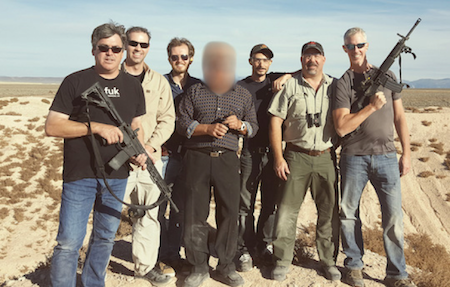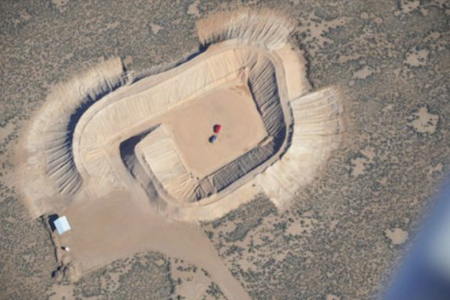Last fall, I had the pleasure of spending time with Spy Briefing club director Doug Hill and a few of the other great folks that work with us.
They came out to Spy Ranch, and we had a blast shooting handguns and AR-15s.
Check out our motley crew in the picture below:

From left to right: Addison Wiggin, Jason Hanson, Jason Farrell, JAVELIN, Joel Karlinsky, Jim Amrhein, Doug Hill
During this firearms training, I ran these guys through several drills, including shooting and moving.
If you have to defend yourself in real life, you probably won’t be standing still while shooting. And depending on the situation, you could be moving away from or toward the threat.
In addition to shooting while moving, another drill we do at Spy Ranch is called the “around the world” drill.
The way this drill works is we set up targets a good distance apart from each other in different areas of the range.
Then someone goes into the range (with an instructor following him or her for safety), where they’ll run from target to target shooting each one. It can be quite challenging at first, because the targets are in all different directions of our 360-degree range.
To get a clearer picture of what I mean, here’s an aerial view of the range:

The reason the around-the-world drill is so important is because it gets your heart going and you have to be able to get to your target, acquire a sight picture and do a proper trigger press while keeping track of all the targets surrounding you.
However, most people don’t have access to a 360-degree range to do these kinds of drills. So here are four simple training drills you can do by yourself to sharpen your skills and increase your confidence if you ever find yourself in a high-stress shooting scenario:
Ice Drill — One such drill I recommend trying is the ice drill. For this drill, fill two bowls with ice water and place your hands in them. After a few minutes, remove your hands and practice safely dry firing your weapon.
This is a useful drill because in a nerve-racking situation, your hands often function similar to how they do after submerging them in a bucket of ice — slow and stiff. In other words, it’s tougher to manipulate your gun when you’re stressed.
Timed Drill — Adding a timer to any firearm training exercise is another effective way to put a little pressure on yourself. One drill that adds pressure is when you start with a completely disassembled firearm. In this drill, you must put your firearm together and fire a round within a certain amount of time.
Penny Drill — This shooting drill will improve your trigger pull and really force you to concentrate. Put a penny on your front sight and then pull the trigger. If you have a smooth trigger pull, the penny shouldn’t fall off. If it does fall off, that means you’re not pulling the trigger straight and to the rear in one fluid motion.
I suggest having a partner to help you with the penny drill because it becomes incredibly frustrating to do this drill by yourself.
Exercise Drill — Finally, here’s another simple drill that will help you become a better shooter during a stressful situation. All you have to do is increase your heart rate. For example, you could do 50 jumping jacks or push-ups and then practice dry firing.
You’d be surprised at how much more difficult it is to shoot when you exercise beforehand.
All of these drills are pretty straightforward and don’t require a huge, elaborate training facility. Any gun owner can do them in the comfort of their own home. Or if you are able to find a range that will allow you to do these drills and then shoot live rounds, that’s even better.
Studies suggest that during an actual shooting, our bodies and minds perform at half the level they normally do during a regular day at the shooting range. This is why it’s so important to train under different conditions and practice on a regular basis.
Now you know a few easy ways to add some stress to your dry firing. Try them and if the day ever comes when you must use your skills, you’ll be better prepared to protect yourself and your family.






